Analysis
What Audio Engineers Should Know About IT & Networking
You don’t need to be an IT or Network Engineer to work in the audio production industry, but understanding a few essential IT and networking concepts can be extremely beneficial. This is especially true as more studios, churches, and live sound companies integrate network protocols into their audio systems.
Understanding Audio-Over-IP
The first thing to understand is the difference between analog audio over an Ethernet cable, digital audio over an Ethernet cable, and digital audio over an IP network.
You can send four channels of analog audio over an Ethernet cable using each of the four pairs of wires, effectively creating a very affordable four-channel analog audio snake.

When you move to a digital protocol like AES50, you convert the analog audio to digital, allowing you to send dozens of channels of audio between two devices in a point-to-point connection.

When you send audio over an IP network, like the one in an office building, school, house, or studio, it opens the doors to much more flexible routing and monitoring. Using an audio-over-IP solution, devices are connected to a common network and can route audio to and from any other device using an appropriate protocol like Dante.
A Dante system can range from a large network with many audio and video devices to a small live sound system with just a console and a couple of stage boxes. One of the main strengths of audio-over-IP is scalability—you can add devices simply by connecting them to the network.
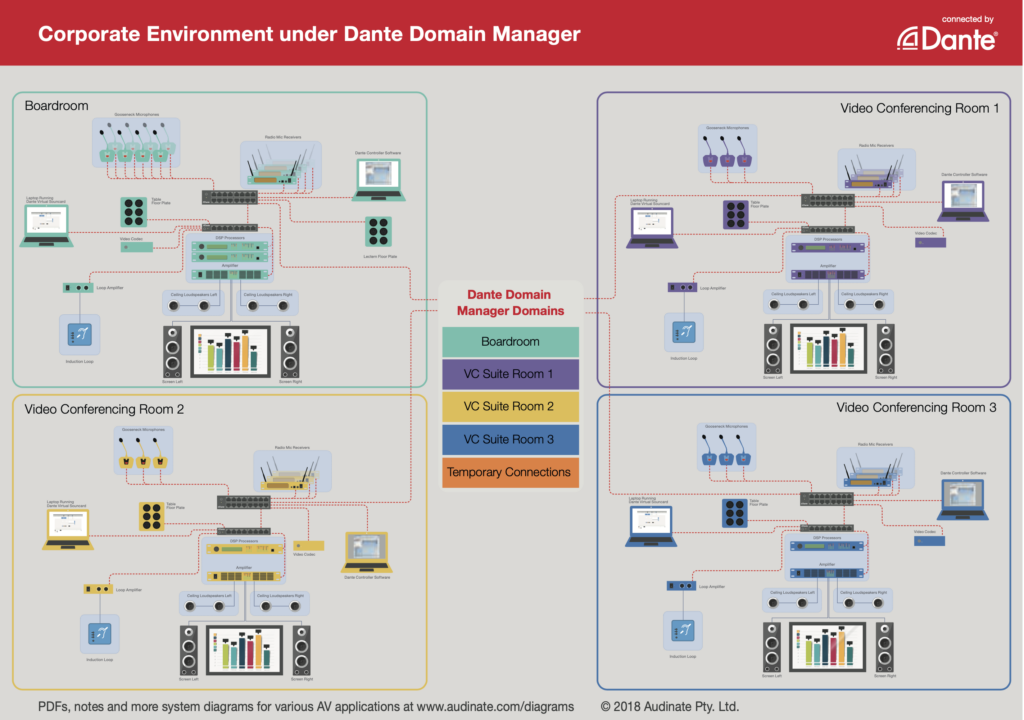
When a Dante device is connected to a network, all Dante devices on the network automatically elect a Master Clock source. Once these devices are locked in, you can send audio throughout the network by selecting a crosspoint in the free Dante Controller software. Transmissions can be one-to-one (unicast) or one-to-many (multicast). This setup might seem complex at first, but once you’ve designed and used a few of these systems, you’ll see just how powerful and relatively inexpensive audio-over-IP can be.
The setup is simple, but there are a few basic concepts to be aware of when working with an audio-over-IP solution.
IP Address, Subnet, & DHCP
Understanding IP addresses is crucial in audio-over-IP systems. An IP address acts like a phone number for a device, allowing devices on a local area network (LAN) to communicate.
Most audio systems operate solely on the LAN, where each device connects to a network switch. For example, a mixer with Dante built-in can connect directly to the network switch, while stage inputs and powered speakers (which only have analog audio connections) can use a Dante stage box and Dante AVIO analog output adapters to connect.
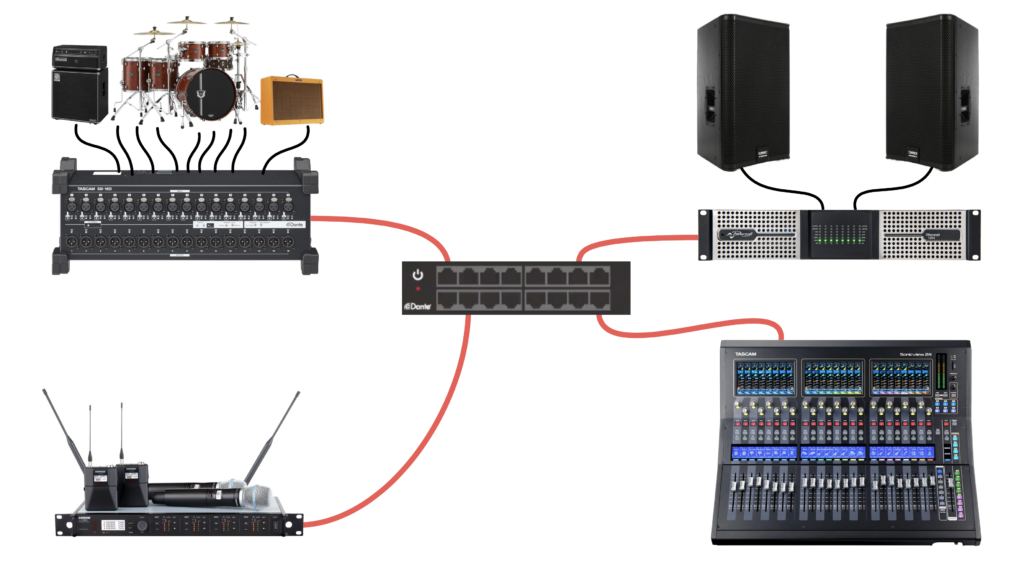
Let’s say we have some inputs on stage, a pair of powered speakers, and a mixer. The mixer has Dante built-in so we can connect it directly to the network switch.�
Meanwhile, the inputs on stage and the powered speakers only have analog audio connections. So, to connect the microphones to the network, we can use a stage box with Dante connections. And to connect the powered speakers to the network, we can use one of these Dante AVIO analog output adapters.�
The inputs and outputs connect to the Dante devices with XLR cables and the Dante devices connect to the network switch.�
In some cases, we could just connect the mixer directly to the stagebox, but for the sake of understanding how the system works, let’s use a standalone network switch. And let’s also connect a laptop to the switch and open up the free Dante Controller software.�

As we can see in Dante Controller, each device now has an IP address.�
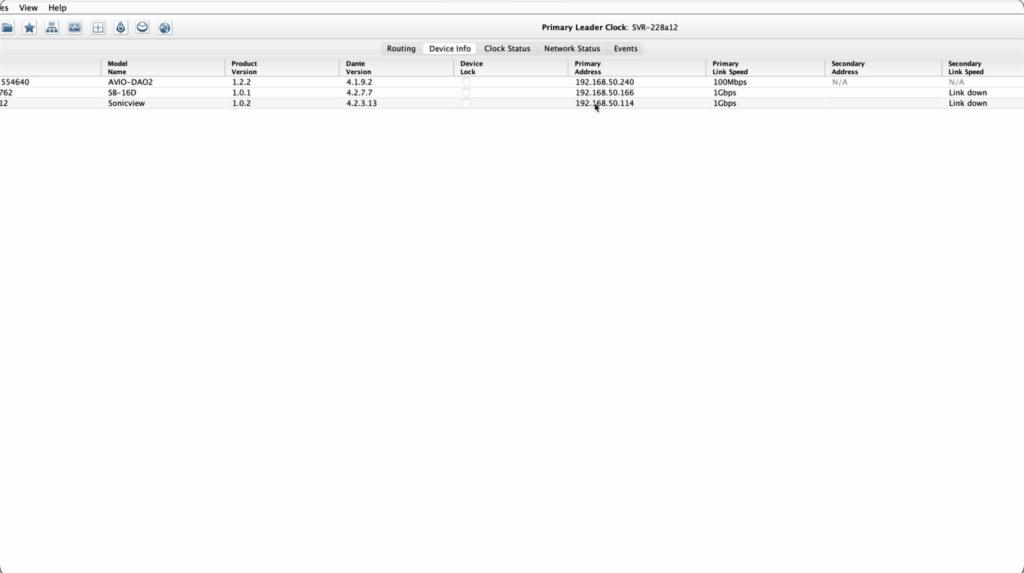
I won’t go into binary math here, but just know that each field in an IP address can range from 0 to 255 (a total of 256 values, represented by 8 bits which are either 0 or 1). All 0’s equals 0. All 1’s equals 255. And every other combination of 0s and 1s represents a number between 0 and 255.�
Notice that all of these IP addresses have the same values in the first 3 fields: 192.168.50.x
In order to understand why this is the case, let’s start with the question, “Where does the IP address come from?”.�
In this case, both my computer and the Dante device are set to “Obtain an IP Address Automatically”. What does this mean exactly?
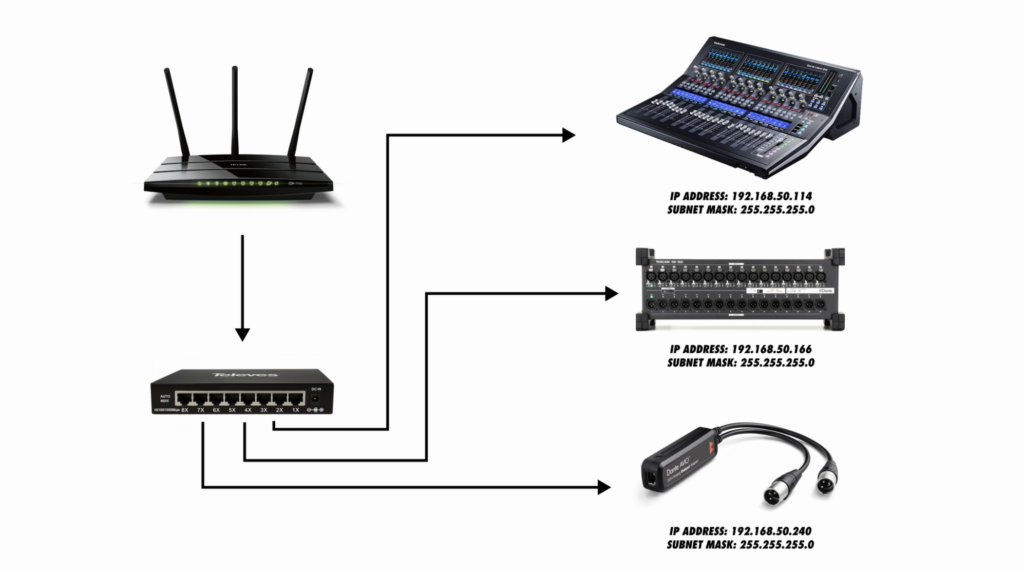
There is a DHCP server on my network, which automatically assigns an IP address and a subnet mask to each device. With the first three fields of the subnet mask being 255 and the last being 0, each device will be assigned an IP address within the range of 192.168.50.1-254.�
The first IP address is reserved, so this means we can have up to 254 hosts in this subnet. It also means that devices with a 255.255.255.0 subnet mask can only communicate with devices within this subnet (where the first three fields of the IP are these values).
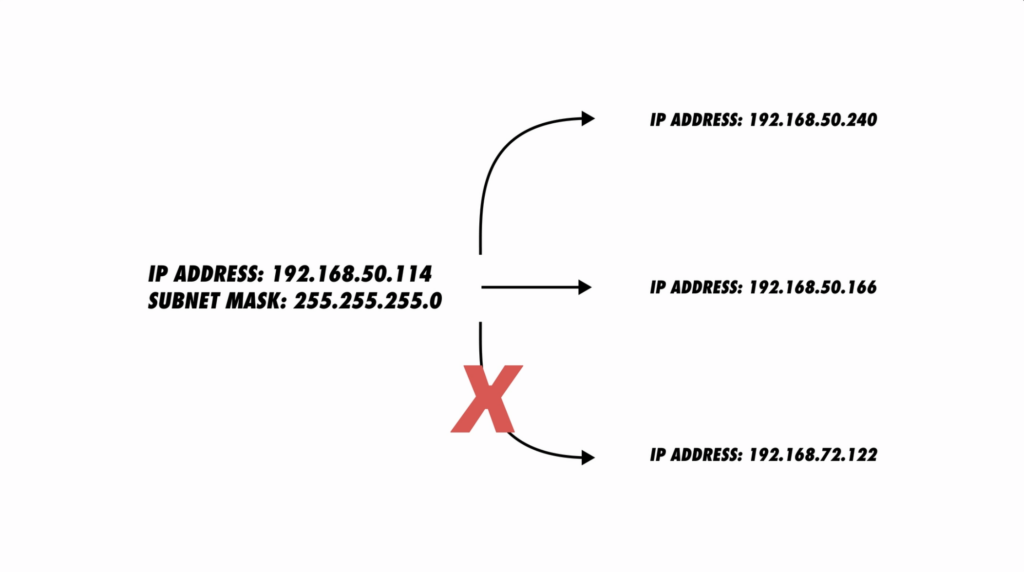
This setup is probably pretty similar to the setup you’ve got going on in your home network or your corporate network. The DHCP server is most likely built into your WiFi router.�
But what if you don’t have a DHCP server on your network?
In this case, each device looks for a DHCP server on the network to assign it an IP address. But when they realize there is no DHCP server, they stick to what’s called a “Link Local” address. These IP addresses are in the range of 169.254._._ with a subnet mask of 255.255.0.0.�
This subnet allows for a total of 65,534 total hosts because the extra field that’s available within this subnet adds more potential combinations.�
If you don’t want to use a DHCP server OR Link Local to automatically set an IP address, you can choose to manually set a static IP address. But the same basic rules apply…
You need to ensure that each Dante device (and the Dante Controller computer) are given unique IP addresses on a compatible subnet.�
Again, there’s a lot more to this than I’ve shared with you here. But these are the core concepts that I’ve found most helpful to understand, and I think they will cover you in 80% of situations you’ll find yourself in as an audio engineer. Go on to the Dante Level 1 and 2 certifications if you wish to go deeper into these subjects.�
Identify & MAC Address
In Dante Controller, instead of just showing IP addresses, you see a list of device names. You can customize these names under the “Device Config” tab, which helps keep track of devices.
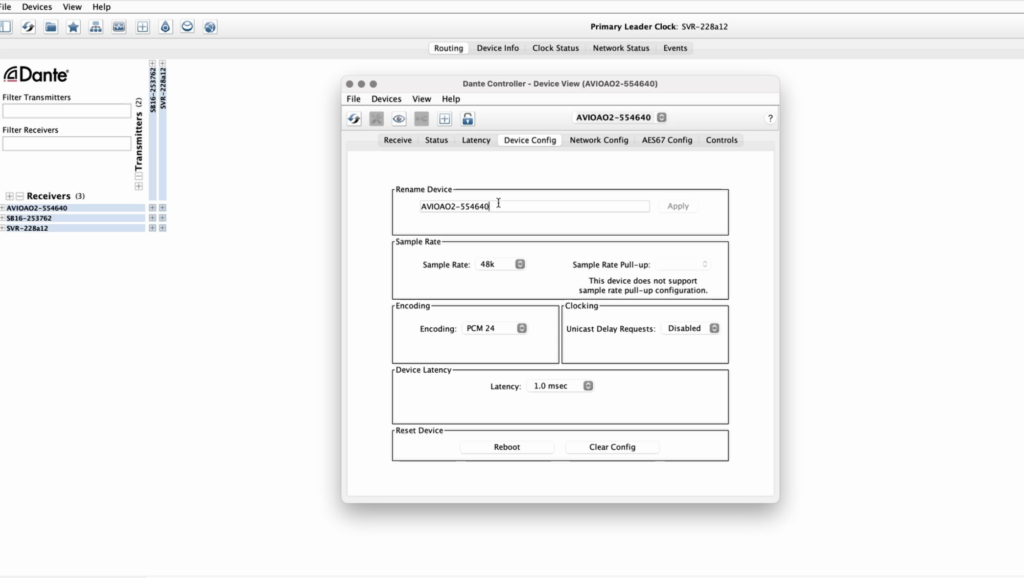
But sometimes (such as when you’re setting up a new Dante network), you’ll see a bunch of default names on the screen. In these cases, it could be difficult to know which device is which… Of course, I’ve got a few tips for you…�
First, in a Dante system you can double-click on a device to open the Device View and then navigate to the “Identify” button under the “Devices” tab. This will usually trigger a flashing light on that device so you can name it appropriately.�
But if your device has no lights, or if it’s above a projector in the ceiling, here’s another tip. When you’re installing a networkable piece of hardware like a Dante wall plate transmitter for example, keep a record of which devices were installed in which locations.�
Of course, you won’t know the IP address until you connect it to a network, and anyway the IP address could change down the road. But you CAN write down the serial number of the device and its MAC address. These two numbers are permanently assigned to the hardware itself.�
With this info documented, we can easily identify each device by its MAC address, which is shown here in Dante Controller.�

If you’re not using Dante Controller, you can also see MAC addresses by typing the command “arp -a” into your computer’s terminal. This will return a list of all the devices that are visible on the network, based on the IP address and subnet mask of your computer.�
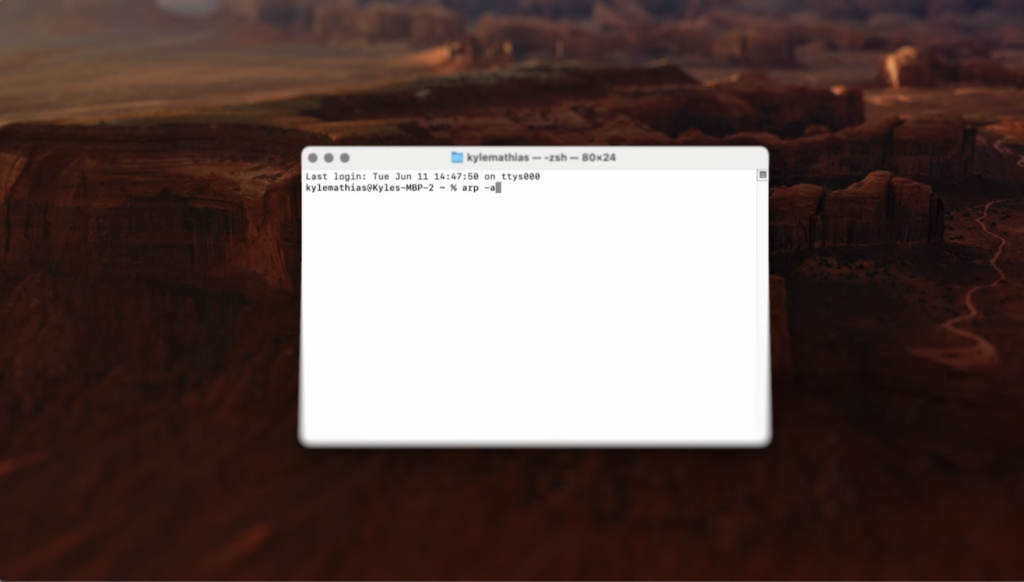
If you know the IP address of the device you’re trying to communicate with but you don’t see it in a discovery tool like Dante Controller, try this…
Open up the terminal on your computer and type in “ping” and then the IP address you’d like to reach. If you see a response, that means the device is reachable with your computer’s current network settings. But if you don’t see a reply, you may need to do some extra troubleshooting…
Remember – the MAC address is a unique address that is permanently assigned to a device at the factory. And on the network, that MAC address is assigned an IP address, which will be used for communication through the switch.�
A helpful thing to understand here is that a device like a laptop can have more than one MAC address. Each NIC (or network interface card) has a MAC address. That’s why it’s so important to check which NIC you’re configuring in your computer’s network settings and which NIC you’re using within Dante Controller.�
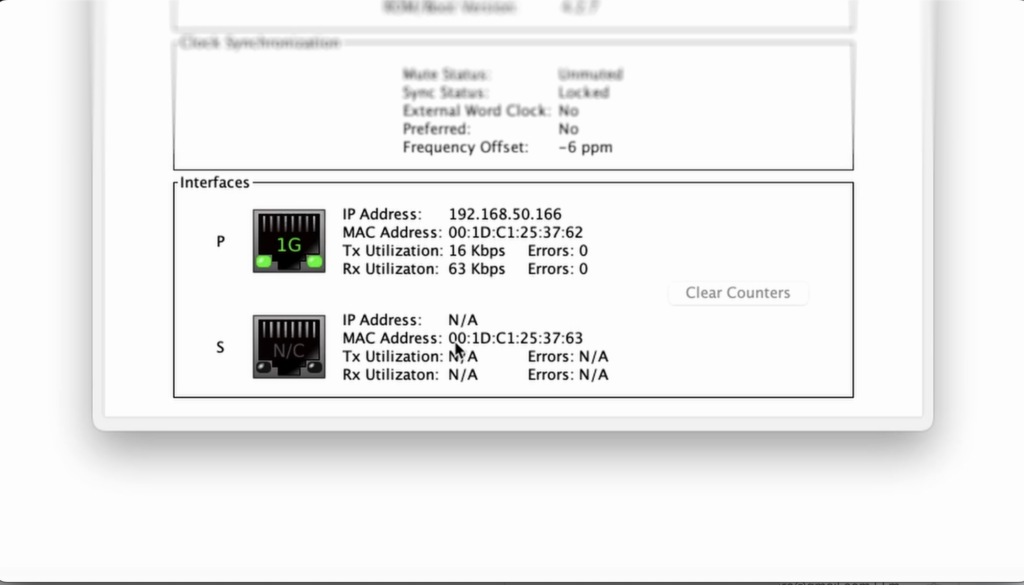
I could be connected properly to the Dante network with my network adapter, but I won’t see anything in Dante Controller if I’ve selected my WiFi adapter in the settings…�
Verify that you’re using the right network adapter. If you’re still having trouble after that, you can try disabling WiFi and try again.�
As I mentioned before, systems like Dante are usually incredibly easy to set up (with or without IT knowledge). But when things require a bit of configuration, these tips I’ve shared with you should become very helpful.�
If you plan to work in professional audio, I’d recommend you go through Dante Level 1 and Level 2 certification. These go into much more detail than I’ve gone into here, and it’s also a useful certification to have on your resume.
